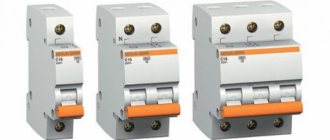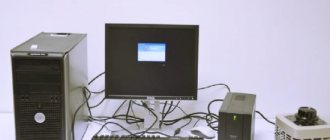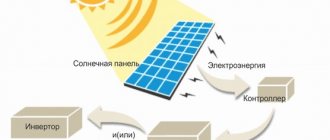Surge filter button - review and repair A surge protector is a useful device that protects sensitive electrical appliances from power surges and
Reading time: 21 min Category: Audio
- Recommendations
- What criteria are important when choosing?
- Criterias of choice
- How to repair an extension cord yourself?
- Surge filter button - review and repair
- Can it be repaired?
- Accounting and tax accounting for equipment write-offs
- xTechx.ru
- Surge protector extension cable SVEN Fort. Review
- How to take it apart correctly?
- The uninterruptible power supply turns off by itself
Recommendations
If you have already decided to disassemble the filter, then at the same time check all other components for serviceability. Quite often, it is not fuses and buttons that fail, but a varistor, which is also needed to protect outgoing lines from high voltage.
Many people do not know the rules for operating network filters and connect them to uninterruptible power supplies, which leads to breakdown of the protective circuits. Also, you cannot connect the filters to each other, because a series connection will multiply the current in the ground phase, and the voltage power will increase above 3.5 kW. This applies specifically to devices with filters, and not just extension cords with a power button.
In addition, it is very undesirable to connect devices with high input voltage to simple models - not only will this not save them from burning out, but it will also quickly damage the filter itself.
How to repair a surge protector, see below.
Source
Main malfunctions and their causes
In working condition, the power cord must protect the connected devices from power surges; for this purpose, a fuse is built into it.
But sometimes problems arise that become noticeable only during operation. All reasons can be divided into two points:
- violation of the physical integrity of external parts (cable, button, sockets or plug);
- combustion of the insides of the block (tracks on the printed circuit board, automatic thermal fuse, switch contacts).
If the extension cord begins to malfunction, as evidenced by an uncharacteristic crackling sound, sparking or blinking of the LED, it must be immediately replaced or disassembled.
It is strictly not recommended to use a broken filter, because the very first power surge can burn out all the expensive equipment that is connected to it.
The device is a plastic case with sockets (sockets) for Euro plugs extending outwards. Contact plates sometimes become deformed if they are made of low-quality cheap metal, which leads to backlash and signal interruptions. In addition, the plug itself heats up, which often leads to its burnout, the plastic may melt and even a short circuit and fire may occur.
What criteria are important when choosing?
If the filter that was inside before breaks down, it’s easier to just pull out the old device and pick up an analogue in the store. Or take advice from sellers. You can tell about the model of the machine you are using. But most consumers prefer extension cords because they are convenient.
Parameters that matter
They are not as difficult to figure out as it seems at first glance.
- How many ports or outlets are used? To do this, you need to think about how many operating devices will be constantly nearby. The number of cables throughout the apartment will be reduced if several devices are connected to one extension cord. This contributes to a decrease in the overall level of safety. The principle of operation does not matter.
- The length that the surge protector must have. Its usual limit is 1.8-5 meters. Three meters will be enough in most situations. Specific numbers depend on where exactly the washing machine itself is located.
- Maximum load indicator. Thanks to this parameter, it is easy to find out what maximum burst of energy the filter can withstand. 2500 J is the standard level for professional-type filters. The basic version is 960 J. Some models have additional lightning protection, but such functions only increase the cost. Advanced or universal protection is the optimal solution for ordinary buyers.
- Response speed. An indicator that plays an important role. It will determine how quickly the operation of the washing machine will be blocked. And how much damage a jump can cause to internal components.
- Purpose of the structure. In particular, you need to understand what specific equipment the filter is intended for.
- Types of fuses used, their total number. Fuses are no less important. Options with several are the most convenient. The main one gets the fusible function. The rest are made thermal, with a quick response, auxiliary.
- Using various indicators in work. Indicators make it easier to identify operational stability. The LED light will be on if everything is ok. If not, then there will be no signals.
- Availability of additional instructions. This indicates that the product is of high quality. It is recommended to give preference to well-known brands that have already been tested in practice more than once.
A high quality extension cord cannot come with a low price. If the device costs too little, perhaps this is the simplest option, without additional protection.
Description
The monitor turns off by itself while the computer is running. At the same time, the computer continues to work - sounds are heard. After rebooting, the screen works for a while, then goes blank again. Most often this happens during:
- Games.
- Watching the video.
- Working with any program.
- Using scrolling on a laptop.
And:
- The video card may start to make a lot of noise.
- The monitor may go dark on both a desktop computer and a laptop/monoblock.
- The time that the computer works after loading Windows varies - from a few seconds to several hours.
- The longer the monitor runs, the more often it turns off.
- The monitor may turn off and on, or it may turn off with the message “no signal”.
- It can be permanently turned off. But when you turn it on, you can see the loaded operating system desktop.
If, in addition to the monitor, the computer turns off, go to the article The computer turns off. If after rebooting the monitor still does not turn on and the computer has stopped showing signs of operation, read ways to solve the problem The computer or laptop will not turn on.
Criterias of choice
In this case, first of all, you need to pay attention to the maximum pulse overload current and the maximum current consumption, the value of which should be 2-3 times higher than that of the washing machine (calculated from the power). You can also temporarily replace a broken filter with an external auxiliary filter, which itself is connected to the mains via an outlet, and all electrical appliances are connected to it.
You can also temporarily replace a broken filter with an external auxiliary filter, which itself is connected to the mains through an outlet, and all electrical appliances are connected to it.
How to repair an extension cord yourself?
- Wired
- Wireless
- Access control system kits
- ACS kits
- Intercom kits
- Ready-made alarm kits
- Wired
- Wireless
- CCTV
- Kits
- For 1 video camera
- For 2 video cameras
- For 3 video cameras
- For 4 video cameras
- For 6 video cameras
- For 8 video cameras
- Security cameras
- IP
- AHD
- HD-CVI
- TurboHD (HD-TVI)
- DVRs
- AHD
- HD-CVI
- TurboHD
- IP
- Hybrid
- Turnkey video surveillance
- For home
- For apartment
- For the store
- Portable
- Video baby monitors and baby monitors
- For hunting and fishing
- Thermal imagers
- Information storage devices
- Hard disks
- Flash cards
- Video accessories
- Services
- Security and fire alarms
- All goods
- Covi Security
- Ajax
- Altronics
- Orion
- Tiras
- Satel
- Arton
- Danube
- GSN Electronics
- Elmes Electronics
- GSM alarm
- GSM alarm kits
- GSM control panels
- Ready-made kits
- Wireless
- Wired
- Fire alarm
- Devices
- Expansion modules
- Sensors
- Keyboards
- Accessories
- Remote security
- Keyboards
- Communication modules
- Security central stations
- Expansion modules
- Accessories
- Alarm sensors
- Wireless
- Vibrations
- Flooding
- Wired
- Panic buttons
- Gas sensors
- Motion sensors
- Opening sensors
- Fire sensors
- Light and sound devices
- Sirens
- Alarm accessories
- Power supplies
- Batteries
- Key fobs and receivers
- Keyboards
- Signal cable
- Antennas
- Water leakage monitoring systems
- Autonomous alarms
- Perimeter security
- Services
- Intercom systems
- Video intercoms
- IP intercoms
- Standard
- Call panels
- IP panels
- Standard
- Accessories for intercoms
- Access control
- Access control and time tracking systems
- Ready-made kits
- Controllers
- Readers
- Software
- Accessories
- Locks and latches
- Biometric
- Electromagnetic
- Electromechanical
- Crossbars
- Door closers
- Turnstiles
- Wickets
- Full height
- Tripods
- Street
- Rotary
- Protective roller shutters
- External
- Domestic
- Automatic
- Manual
- Automation for gates
- Barriers
- Spherical mirrors
- Road
- Overview
- Anti-theft systems
- Gates
- Showcase protection
- Safety sensors
- Visitor counters
- Removers/deactivators
- Smart House
- Metal detectors
- Metal detectors
- Entry level
- Mid-level
- Professional
- Accessories for metal detectors
- For security services
- Manual
- Arched
- Communications and networks
- network hardware
- Switches
- Routers
- Access points
- Notification and voiceover
- Loudspeakers
- Amplifiers
- Microphones
- Various accessories
- Mounting equipment
- Cable production
- Connectors and adapters
- Installation tool
- Walkie-talkies, intercoms
- For Truckers
- Waterproof
- Portable
- For Taxi (in the car)
- Mounting cabinets
- Touch information panels
- Counter-espionage technology and safes
- Safes
- Banking
- Furniture
- Fire resistant
- Armory
- Built-in
- Archive cabinets
- Cellular cabinets
- Key holders
- Data protection
- Noise generators
- Telephone security devices
- Protection of negotiations
- Search technology
- Scanning receivers
- Frequency counters
- Signal detectors
- Search complexes
- Inspection equipment
- Video camera detectors
- Accessories / Antennas
- Leisure and tourism
- Walkie-talkies, intercoms
- Knives and multitools
- Tourist
- For hunting
- For fishing
- Folding
- Optics
- Binoculars
- Microscopes
- Telescopes
- Lanterns
- Accessories
- Energy security
- UPS
- Interactive
- Continuous action
- Reserve
- Stabilizers
- Single-phase
- Relay
- Batteries
- Power supplies
- Auto safety
- Car cameras
- Car recorders
- Full HD 1080p
- HD 720p
- With motion sensor
- Car recorders
- Car navigators
- Night driving devices
- Parktronics
- Rear
- Front
- With screen
- Car alarms
- Unilateral
- Double sided
- Car locks
- Blockers
- Radar detectors
- Cable
- Coaxial cable
- Signal cable
- Power cable
- twisted pair
- Cable accessories
Surge filter button - review and repair
A surge protector is a useful device that protects sensitive electrical appliances from power surges and impulse noise.
Externally, a household filter resembles a regular extension cord, but it is additionally equipped with a built-in unit that absorbs all frequency fluctuations.
To protect against large surges, the device is equipped with a fuse, which in case of critical overloads instantly disconnects electrical appliances from the network.
Like any other devices, surge protectors can break down during intensive use.
First, when turned on, it begins to spark, heat up and make strange sounds, and over time it stops working altogether. If the filter is used frequently, the button may wear out physically or become mechanically damaged.
Attention! If the surge protector button begins to spark, heat up and/or crackle, further operation of the device is unsafe! You should immediately disconnect the filter from the mains to avoid fire! For safe operation of the filter, you need to check the condition of the switch contacts and, if necessary, clean them of carbon deposits. Let's look at the button diagram of a typical surge protector:
Let's look at the button diagram of a typical surge protector:
As can be seen from this diagram, there is nothing complicated in the design of the surge protector power button, so you can repair it or replace it with a new one yourself.
Repair - what to do if the surge protector button is broken
If, when you turn on the surge protector button, extraneous sounds begin to be heard, which are accompanied by the smell of melting plastic, the device should be immediately de-energized. Next, you need to disassemble the surge protector and check the condition of the contacts on the switch.
To do this you will need the following tools:
- soldering iron,
- crosshead screwdriver,
- tester,
- sandpaper-zero.
If the contacts are burnt out, the tester readings will confirm this (in this case, there will be no voltage at the output from the button in the “On” position). To clean the contacts, the switch needs:
- Disassemble the surge protector housing by unscrewing the mounting screws;
- Unsolder the button and remove it from the filter housing. The button is held in the housing by plastic clips, which should be carefully squeezed out.
- Disassemble. To do this, you need to disconnect the key by picking it up with a flat-head screwdriver.
- Take out the contacts and clean off any black deposits.
- Assemble the button. After this, we assemble the button in the reverse order, install it in place and solder it.
If the contacts have burned very badly and melted the plastic of the switch housing, it should be completely replaced.
To do this you need:
- Disassemble the filter;
- Unsolder the button;
- Remove the switch from the housing;
- Install a new one in its place (sold in radio parts stores, costs about 30 rubles);
- Solder the button and assemble the filter housing.
Often the button on the surge protector does not work due to mechanical damage. The most common case is the breakdown of the latches that hold the switch key in the housing. In this case, it is not necessary to buy a new button - the latches can be restored.
To do this you will need the following materials and tools:
- screwdriver (or drill) and drill with a diameter of 3.5 mm;
- toothpick;
- cotton swab;
- side cutters.
The process itself is very simple:
- A through hole is drilled in the key into which a cotton swab is inserted (it will act as a latch).
- A toothpick is inserted inside the cotton swab for greater rigidity. On both sides, the improvised retainer is trimmed with side cutters so that on each side it protrudes approximately 3-4 mm.
- Now all that remains is to insert the key into the body - to do this, just slightly bend the sides of the seat with a screwdriver.
VIDEO INSTRUCTIONS » alt=»»>
How to make a surge protector directly, without a button
If the old button has completely failed and you don’t have a new one at hand, you can connect the surge protector directly, turning it into a regular extension cord.
To do this you need to do the following:
- Open the mains voltage filter housing by unscrewing the mounting screws with a screwdriver;
- Unsolder the wires from the button and solder them according to color, bypassing the button;
- Insulate the joint with insulating tape or heat shrink;
- Assemble the extension cord and test its functionality.
To avoid the surge protector switch problems described in this article, consider the maximum power rating of the connected load and the maximum load current when selecting a device.
VIDEO REVIEW » alt=»»> If the total power of the equipment exceeds the maximum permissible filter power, then you should opt for a more powerful model.
UPS malfunctions, description
A UPS failure puts all equipment at risk, so you should know how to check the UPS and its battery for functionality. Methods for eliminating minor faults are necessarily described in the user manual for the device, so it is recommended that you study it first. If this does not work, you should try to identify the problem yourself.
Beeps continuously
The UPS starts beeping if the power is turned off and the equipment switches to battery power. In this case everything is fine. It is for these purposes that this device was created. The user just needs to shut down the entire system and turn off the power to the device.
If such a squeak occurs regularly, while there is voltage in the network, you may need to test the electrical network and understand the causes of power surges. In this case, the uninterruptible power supply is not to blame, the problem is elsewhere.
Pay attention to the device indicators
Another reason for the UPS beeping is overload. In this case, the device does not pull the equipment connected to it. You can determine the source of problems by connecting and disconnecting devices one by one. The solution to the problem will be to purchase a more powerful uninterruptible power supply or turn off part of the equipment.
Doesn't turn on after power is applied
If electricity appears in the network, but the UPS does not turn on, you should check the health of the battery, the connection to the network and the voltage level. The UPS will not be able to operate for a long time if the network voltage is low for a long time. In this case, the battery will be discharged and the device will no longer turn on.
Sometimes, it is enough to connect the UPS to the network and just wait a while, the battery will charge and the device will start working. You should know how to check the UPS to see if its power button is working; it may be pressed. Wire breaks are a common problem with uninterruptible power supplies. When there is a heavy overload, some brands of UPS refuse to work; it is enough to turn off everything and check that it turns on independently.
It turns itself off and gets very hot
If there is voltage in the network, the uninterruptible power supply may turn off due to an overload at the output
It is important to consider at what point the device turns off. If during a power outage, then most likely the problem is in the battery, you should check its performance
In the case when the device disconnects the load while operating from the network, it is quite possible that the software settings are to blame. You should check the standard settings and adjust them if necessary.
After opening the case, you can notice obvious problems
The reason for unstable operation of the device may be the use of non-branded accessories. In addition, it is likely that other problems will appear in the operation of the UPS. The uninterruptible power supply may turn off due to overheating. In this case, you should check the serviceability of the cooling system and make sure that there is no debris obstructing the free circulation of air, otherwise the device will turn off.
The UPS should be selected carefully, according to the voltage of the connected devices. If there is an overload, the uninterruptible power supply will turn off, just as if there is insufficient load. Devices from some manufacturers detect a load below the set power as the absence of working devices and turn off to preserve their own charge.
Can it be repaired?
Depending on the cause of the breakdown, surge protectors are quite suitable for repair; the main thing is to have at least a little experience working with a soldering iron and a screwdriver. Before you begin, carefully inspect the outside of the appliance. Sometimes, to fix it, you don’t even have to disassemble it - it will be enough to replace a burnt or broken plug. When there are no external signs of failure, but when under load it makes strange sounds, then most likely it is the chokes (pulse voltage absorbers in the form of a coil) cracking.
When you need to change the fuse, this is also not a problem.
If the button does not work when turned on, the backlight does not light up, it is also not necessary to solder it right away - you can simply pull the switch body out of the socket, clean the contacts and carefully put it back in place
The button does not turn off
If the fuse is blown, then the button (the one without an LED, separate from the “on/off”) stops pressing and constantly sticks up, which means emergency mode without electricity supply. It is enough to unsolder it or unscrew it (depending on the model) to take it to a radio parts store, where the seller will pick up exactly the same one. It happens that the model you need is not on sale - no problem, you can connect the wires directly with your own hands without buttons. Then, instead of a surge protector, you will have an excellent extension cord, which will be quite useful for charging low-voltage devices, lamps and radios.
The light is flashing
The power switch button may turn off spontaneously or become completely stuck in the “on” position. Sometimes the power indicator starts blinking for some unknown reason. This also indicates that it is most likely time to clean the contacts. After disassembling the case, you need to remove everything that covers the button, unscrew the screws from the printed circuit board (to turn it over) or unsolder the power cable and button legs. After this, you can pull out the switch box and use a flat-head screwdriver to unhook the latches that hold it in the socket.
Inside there are contacts made of springy steel. Over time, they become covered with a layer of soot and oxide, so the contact area begins to heat up more than usual. If you clean them with sandpaper or a file, the button will no longer overload and turn off. At the end, you can treat the stripped areas with alcohol and blow them out, and then assemble the switch and solder it back.
Sparks
If the surge protector sparks when turned on, this indicates, rather, that the insulation of the internal contacts has been damaged, rather than that some part has broken. Look inside, check and, if necessary, use a tester to call where the wires might have come loose. If found, take more solder, because cheap Chinese factories often suffer from indecently flimsy soldering quality and savings on literally everything, including tin.
Keep in mind that sparking and cracking can occur not only due to a defect in the surge protector, but also due to a weak socket that is not designed for heavy loads. To check, find a good outlet or disassemble an existing one (after de-energizing it) to look for problems with the twists in the reconnaissance boxes (especially for Soviet aluminum ones).
Other breakdowns
Mechanical damage to the switch latches due to breakage and melting of the plastic is also possible. In this case, a hole is carefully drilled in the button body and a cotton swab or toothpick is inserted, acting as a latch that is inserted into the groove. After these simple manipulations, you can return the switch to its place. The surge protector is ready for use again!
If there is no voltage, then look for the section mark on it and buy a replacement of the required length. Next, you should disassemble the plug and body and solder the wires to the contacts, not forgetting to first properly clean and insulate them after soldering.
The UPS does not support the load - this and other failures of uninterruptible power supplies
In case of any malfunction, you should first read the instructions for the device. Depending on the manufacturer and model, the same malfunction may manifest itself in different ways. Diagnosis of each UPS and repair may vary, depending on the definition of typical problems.
Symptoms of uninterruptible power supply malfunctions can be different, but the main ones are:
- does not support the load when the power is disconnected from the network;
- does not turn on;
- The UPS beeps constantly;
- overheats;
- The UPS clicks or shuts down on its own.
In some cases, you will be able to repair the device yourself, but you should remember that the UPS device is electrical and will require basic skills in assembly and disassembly.
Be careful when disassembling the device
The most common problems with uninterruptible power supply systems are dust and battery wear. Both of them arise as a result of long-term use. Equipment needs regular cleaning from dust; you should not leave the device in the room where repairs are being carried out - construction dust is the most dangerous for it.
Accounting and tax accounting for equipment write-offs
The cost of the equipment at which it was reflected in the debit of account 07 “Equipment for installation”, when written off, is generally transferred to the financial results account (Order of the Ministry of Finance dated October 31, 2000 No. 94n):
Debit account 91 “Other income and expenses”, subaccount “Other expenses” - Credit account 07
If equipment is written off based on the results of an inventory and identified shortages, its value is first debited to account 94 “Shortages and losses from damage to valuables”, and only then to the account of the source from which the shortage will be covered:
Debit of account 73 “Settlements with personnel for other operations” - Credit of account 94 - if the guilty person was identified
Debit account 91 – Credit account 94 – if there are no guilty parties or if the court refused to collect from the employee
If the equipment has already been transferred for installation, but is then written off, in the above transactions, instead of account 07, account 08 “Investments in non-current assets” will be used.
Expenses for the liquidation of fixed assets being decommissioned, as well as expenses for the liquidation of other property, the installation of which has not been completed, are taken into account as part of non-operating expenses (clause 8, clause 1, article 265 of the Tax Code of the Russian Federation). If the equipment was lost, then the fact of the absence of the perpetrators must be documented (clause 5, clause 2, article 265 of the Tax Code of the Russian Federation).
Budget accounting
Having considered the issue, we came to the following conclusion: Expenses for the purchase of an extension cord can be made both through Article 310 “Increase in the cost of fixed assets” of KOSGU, and through Article 340 “Increase in the cost of inventories” of KOSGU.
The final decision to classify the acquired property as inventory (fixed assets) can be made by competent officials of the institution within the scope of their powers based on the specific characteristics of the extension cord, taking into account the expected conditions of its use (operation).
Causes of UPS failure
During operation, uninterruptible power supplies may suffer due to overload, insufficient cooling and exposure to the external environment. Among the main reasons for UPS failure for a computer or other electronic devices, the following are worth highlighting:
- Contamination of the board and internal surfaces, causing deterioration in the heat dissipation of parts and short-circuiting of current-carrying paths.
- Depletion of battery life and loss of capacity.
- Drying of electrolytic capacitors, causing malfunctions in the operation of control and power units.
- Contamination or drying of the cooling fan lubricant and, as a result, slowdown of rotation or jamming of the fan.
- Failure of the inverter as a result of overload or prolonged operation at high load with poor cooling.
- Device failure due to excessive input voltage.
- Problems with the input power circuit.
Some of the problems can be solved without special material costs, some require too expensive repairs and become a reason for writing off the device. Let's look at typical UPS problems that their owners encounter.
xTechx.ru
A surge protector (Surge Protector - eng.) is an inexpensive and fairly simple device for protecting electronic equipment from network, high-frequency, low-frequency, impulse noise, overcurrent, and also from short circuits.
There are elements for protection on a special board in the filter housing.
To protect against pulse currents, varistors are used, which are connected in parallel to the connected equipment.
In the event of a sharp pulse jump, the resistance of the varistor increases sharply and the pulse energy is converted into thermal energy (which in some cases breaks the varistor), protecting the equipment if the noise was completely absorbed by the varistor.
To improve filtering of impulse noise, “gas dischargers” are sometimes used in conjunction with varistors (seen in Pilot GL, Pro). They can also be used separately.
High-quality surge protector:
An LC filter is used to filter out high-frequency interference (radio interference). This type of interference can interfere with the operation of electronic equipment (mainly high-precision equipment).
They are created by electric motors, welding machines, generators, electric dischargers of gas stoves, etc. Filtration efficiency is measured in dB. The higher the number, the better.
The filter may include inductors and capacitors (together or separately does not matter). They help improve durability, stability, and reduce the load on internal filtering systems of audio-video and computer equipment. Also, surge protectors use “button” type current limiters, which cut off the power if the permissible current consumption is exceeded
Although in cheaper versions, the tie is not on power consumption, but on temperature
Also, surge protectors use “button” type current limiters, which cut off the power if the permissible current consumption is exceeded. Although in cheaper versions, the problem is not on power consumption, but on temperature.
Also, in many types of filters, additional fuses are used, which in addition insure varistor protection. If they are triggered, the device must be opened and the element replaced with a new one.
Does the filter protect against interference if there is no ground connection at the ground pin?
For a good surge protector, it is not so important whether there is grounding or not. Still, the filter specifications must indicate “3-phase protection” or “phase-zero, phase-earth, zero-earth protection.” Still, the filter specifications must indicate “3-phase protection” or “phase-zero, phase-earth, zero-earth protection”
Still, the filter specifications must indicate “3-phase protection” or “phase-zero, phase-earth, zero-earth protection.”
This will protect your equipment from pulse surges and means that a varistor is soldered in parallel to each of the phases. Even if there is no grounding contact, “phase-zero” will filter pulse surges.
It is noteworthy that the LC filter, if present, does not need a ground. It will filter high-frequency interference as normal.
Overload and short circuit protection - will function normally and without grounding.
Surge protector extension cable SVEN Fort. Review
- March 19, 2016 at 2:37:17 pm
- 6623
We share our impressions of the SVEN Fort surge protector after a year of intensive use.
But let's start from the beginning.
The design of the filter turned out to be very successful, so this extension cord will fit into any interior. The pleasant matte surface of the case not only looks beautiful, but also has practical value. The matte finish does not show scratches that inevitably occur during use.
On the front surface of the SVEN Fort filter there are 5 Euro sockets with grounding contacts, a common power switch, individual power switches for each socket, an indicator of the presence of grounding and serviceability of the protection.
On the back of the case there are special holes for attaching the filter to a wall or horizontal surfaces, for example, to a shelf
Much attention is paid to the reliability of the SVEN Fort network extender and the safety of its operation
Installation of socket blocks is carried out using solid brass bars, which conduct current well and dissipate heat. The rest of the installation was done with copper wire. The filter itself is mounted on a printed circuit board, which increases the reliability and manufacturability of the product.
To increase safety, double-pole power switches are used. Thus, when you turn off any of the switches, both wires of the outlet are physically disconnected from the network.
The second level of protection is the presence of a fusible and bimetallic thermal fuse that protects the line filter from a short circuit in the load circuit and when the permissible load power is exceeded.
The network filter uses an effective network voltage filtering circuit that can protect equipment from failure when high-voltage impulse noise and high-frequency components appear in the network. To monitor the operation of the circuit and the presence of a connection to ground, two LED indicators are provided.
- Two-pole general switch with built-in lighting;
- Two-pole individual switches with built-in lighting for each socket;
- Indication of serviceability of the protection circuit and the presence of grounding;
- Several powerful varistors to protect the load from impulse noise;
- Second-order LC filter for effective suppression of high-frequency interference;
- Bimetallic switch to limit the maximum permissible load current;
- A fuse to limit the varistor current when exposed to impulse noise, which once again increases operational safety;
- Movable curtains on sockets for safety against unauthorized entry of foreign objects into the housing (child safety);
- Availability of mounting holes for wall mounting;
- Impact-resistant, non-flammable housing made of ABS plastic.
| Max. suppressed energy of high-voltage pulses, J | 1050 (3 × 350) |
| Rated voltage, V | 220 |
| Operating frequency, Hz | 50 |
| Total power of connected load, kW | ≤ 2,2 |
| Maximum absorbed pulse noise current, A | 3 × 6500 |
| Suppression of impulse noise, times | at least 10 |
| Interference reduction at frequencies 1-100 MHz (dB), max. | 35 |
| General socket switch | yes, bipolar |
| Individual socket switches | There is |
| Input plug | CEE 7/7 |
| Output sockets | 5 × CEE 7/4 |
| Thermal fuse operation current, A | >10 |
| Ambient temperature | from +10 to +70 °С |
| Air humidity | no more than 65% |
| Cable length, m | 1,8 |
| Dimensions, mm | 122 × 54 × 295 |
| Color | black |
As stated at the beginning of the review, this model of surge protector extender has been in active use with us for more than a year. The filter is covered with a layer of dust and scratches, but it works properly. It seems to us that this is one of the most successful filters presented on the market, including by SVEN.
Based on the combination of qualities and characteristics, the Sven Fort extension filter can be classified as a high consumer category of product, but its price is very affordable.
. And we never had to press this bimetallic fuse button.
SVEN Fort can be purchased with different lengths of power cord.
Our rating:
+ high safety and protection, several levels of protection, good design, quality materials, potentially long service life, affordable price;
— not detected during the year of operation.
Have you heard about the CLUSTERWIN OEL-820 grid load optimizer?
The device solves a serious problem that, before its appearance, could not be solved without significant material costs.
Comparison table of characteristics
Brief hardware specifications of the reviewed devices are presented in the summary table.
| Model | Power, W | Sockets, pcs. | Cable, m |
| DEXP Optimus FP 418 | 1800 | 4 | 1.8 |
| SVEN SF-03L | 2000 | 3 | 2.5 |
| Defender DFS 603 | 2200 | 6 | 3 |
| ERA SF-5es-2m-B | 2500 | 5 | 2 |
| APC Essential SurgeArrest P43-RS | 2500 | 4 | 1 |
| Pilot S | 2800 | 6 | 5 |
| APC Essential SurgeArrest PM5-RS | 3000 | 5 | 1.83 |
How to take it apart correctly?
Disassembling a regular Pilot filter begins with unscrewing the screws, as, indeed, in most other cases, but in some non-separable models the housing may be without bolts using rivet screws. Usually the fastener is installed on the back, it is often covered with factory stickers, but it can also be found on the front, right in the slots of the sockets. For additional fixation, there are plastic latches at the junction of the two halves of the case. When opening, do not make sudden movements or use force so as not to damage the structure. If the device has never been disassembled, there will be a warranty seal on the case.
You can try to push out just the button using a flat-head screwdriver, because in such devices, most often the contacts in the switch become clogged with dust, or the cord itself breaks.
Next, use the tool to diagnose and repair components. You will need:
- soldering iron;
- screwdriver (phillips and flat);
- tester;
- needle file or sandpaper;
- tweezers;
- hair dryer for blowing after cleaning contacts.
The search for defects is necessary in order to make a final conclusion about the possibility of its repair and the advisability of further use. Sometimes the price of the issue is only 200 rubles, so there is little point in correcting the breakdown, but if the filter was powerful, with a reusable fuse, then the cost of such a device can be several times higher.
The uninterruptible power supply turns off by itself
Everyone knows that power surges are dangerous for household and computer equipment, as well as electronic components of power tools and industrial equipment. Unfortunately, power surges are not uncommon in the power grids of our cities, and even more so in villages.
To protect equipment from these phenomena, the UPS device was invented, which is an abbreviation of its name: uninterruptible power supply. UPS is his English. abbreviation.
Thanks to modern technologies, the UPS effectively smoothes out voltage surges and radio frequency interference, and in the event of a complete power outage, it switches to powering consumers from the backup battery.
Diagnostic methods
To make sure that the uninterruptible power supply is working, it is enough to diagnose the electronic unit and battery of the device; you will need a screwdriver and a multimeter for this. There are several main ways:
- using automatic testing, carried out when the device is turned on;
- forcefully, by pressing the “Test” button, also using the included software, thanks to the possibility of remote monitoring;
- by manual force testing, using an input or output breaker, switch, etc.
In addition, diagnostics can be routine and emergency. In the second case, you must refer to the operating instructions for the device. Completely disconnecting the load from the UPS and checking its operation in offline mode allows you to identify many defects in the operation of the device. The charge in the battery can be checked using testers that can measure the battery capacity. You can repair the uninterruptible power supply yourself.











